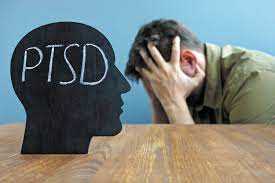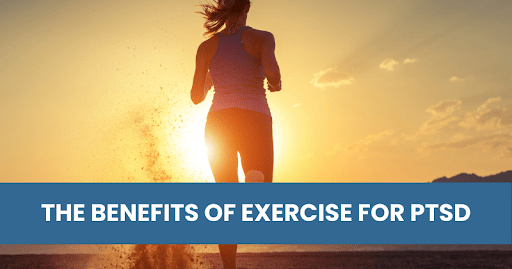Exercise is said to cure a number of ailments, both physical and mental. For many years, doctors have studied the effects of exercise on PTSD. Those studies have yielded a positive result, and prove that exercise is effective in reducing the symptoms of PTSD including depression and anxiety.
When you exercise, you are increasing blood flow to your brain, and organs, and emitting positive endorphins. Exercise is a great addition to other therapeutic methods used to treat PTSD such as therapy and medication. In this article, we will discuss the benefits exercise can bring to those suffering from PTSD.
Contents
What is Post-Traumatic Stress Disorder (PTSD)?

Post Traumatic Stress Disorder, also referred to as PTSD, is a mental health condition that is triggered by a traumatic event–either experiencing it firsthand or witnessing it. Symptoms may include flashbacks, nightmares, and severe anxiety, as well as uncontrollable thoughts about the event itself.
When most people go through traumatic events, they may have temporary difficulties adjusting and coping after the fact, but with some time and good self-care practices, are generally able to return to normal living circumstances. If symptoms continue or get worse, and last for a substantial amount of time, then it may be PTSD.
Post Traumatic Stress Disorder symptoms typically start within one month after a traumatic event has been experienced, but sometimes they may not appear until years after the event. These symptoms can cause issues with day-to-day living, from social situations to work life.
Symptoms are grouped into four types: intrusive memories, avoidance, negative changes in thinking and mood, and changes in physical and emotional reactions. They can vary over time and from person to person.
Intrusive memories symptoms include:
- Recurrent, unwanted distressing memories of the traumatic event
- Reliving the traumatic event as if it was happening again (flashbacks)
- Upsetting dreams or nightmares about the traumatic event
- Severe emotional distress or physical reactions to reminders of the trauma
Avoidance symptoms include:
- Trying to avoid thinking about the event
- Avoiding places, activities, or people surrounding the event
Negative changes in thinking and mood symptoms include:
- Negative self-thoughts
- Hopelessness
- Memory problems
- Difficulty maintaining relationships
- Feeling detached
- Lack of interest in hobbies
Changes in physical and emotional reactions symptoms include:
- Easily startled or frightened
- Irritability and anger outbursts
- Always on guard and looking for danger
- Self-destructive behaviors
- Overwhelming guilt or shame
Benefits of Exercise for PTSD
Your brain is a powerful tool, it is the biggest tool in your recovery and the part of your body that is causing the PTSD symptoms you feel. Exercise can help you rewire those neuro pathways and overcome or rechannel anxiety and depression that arise out of PTSD.
Some of the biggest benefits of exercise for PTSD symptoms include:
- Exercise improves cognitive function. People who suffer from PTSD often experience difficulty with memory and concentration. It is thought that consistent exercise creates new neurons in the brain which improves memory. It is also understood that exercise increases blood flow to the brain. That blood flow brings oxygen and nutrients that support the formation of new memories.
- Exercise curbs feelings of anxiety and hopelessness. Anxiety and hopelessness can be regular feelings for those that suffer from PTSD. Exercise can decrease common stress hormones like adrenaline and cortisol. Exercise also serves as an outlet. When you are experiencing feelings of stress, anxiety, or hopelessness you can use exercise to take your mind off the anxiety symptoms.
- Improves sleep. Sleep is also something that many people with PTSD struggle with. PTSD causes a state of hyperarousal that can make it difficult to relax and fall asleep. Exercise can reduce symptoms of hyperarousal, allowing you to fall asleep and stay asleep.
- Promotes a sense of community and togetherness. Lastly, exercise brings people together. A proven treatment of PTSD is community and support. Through exercise, many PTSD sufferers have found a community of individuals they can share a hobby but also share their emotions and struggles.
Exercising May Be Hard for Some
People suffering from PTSD may find it difficult to exercise because exercise often mimics some of the symptoms of PTSD such as shortness of breath and a fast beating heart. Another symptom of PTSD is depression. Depression can make it very difficult to get out and move around.
Feeling of hopelessness can take over and make doing anything, even something like exercising, very difficult and almost impossible. If you are suffering from PTSD and depression symptoms, it’s really important that you get out and exercise to reduce your symptoms.
Setting Goals for Exercise
Setting goals and sticking to them can be a daunting task, but it’s important. When it comes to exercising to improve psychological well-being after a diagnosis of PTSD, an effective method to use is the SMART goal-setting process.
SPECIFIC, MEASURABLE, ACHIEVABLE, REALISTIC, TIME-ORIENTED
Some examples of this type of goal setting might be the following:
- To jog the full length of a specific park, within an 8-week time frame.
- To attend a local yoga class 1x per week in a habitual manner, over the next 12 weeks.
- To take the dog for a walk/jog for 30 minutes, 3x per week, demonstrating habitual engagement in aerobic-based exercise.
All of these goals are SMART goals, therefore much easier to keep track of and hold yourself accountable for! And better to help those who may be utilizing exercise to help with treatment.
Exercise is Not the Cure But an Effective Solution
Exercise works wonders in combination with the group and talks therapy and medication. If you are suffering from PTSD and are looking for ways to continue reducing your symptoms, try exercising.
Before embarking on an exercise program, it’s important to check with your doctor to make sure you do it safely and effectively. They may be able to help identify the best exercises to pursue.
You can work with your therapist/mental healthcare provider or a representative from the VA to find an exercise group or exercise routine that works best for you. Not only will exercise improve your symptoms of PTSD but it will help you lead an active, healthy life.
Conclusion
In conclusion, you have read about the benefits of exercise for PTSD. Regular exercise can be extremely beneficial for those suffering from PTSD. Not only does it provide an outlet to manage stress and improve mental health, but physical activity can also help reduce symptoms such as insomnia, depression, and anxiety. Exercise increases endorphins, which improves mood and overall well-being. Additionally, it helps build strength and confidence, both of which help individuals cope with the daily struggles associated with PTSD. Regular exercise can be an effective form of treatment for those who are looking to manage their symptoms and lead healthier lives. It is important to remember that everyone’s journey toward recovery looks different, so it is essential to find a routine or activity that works best for you. With dedication, individuals can take steps towards improving their mental health and living a more fulfilling life. You can also take online PTSD counseling services and get help if needed. Overall, regular exercise is an important component of treatment for those suffering from PTSD that can lead to a better quality of life.


